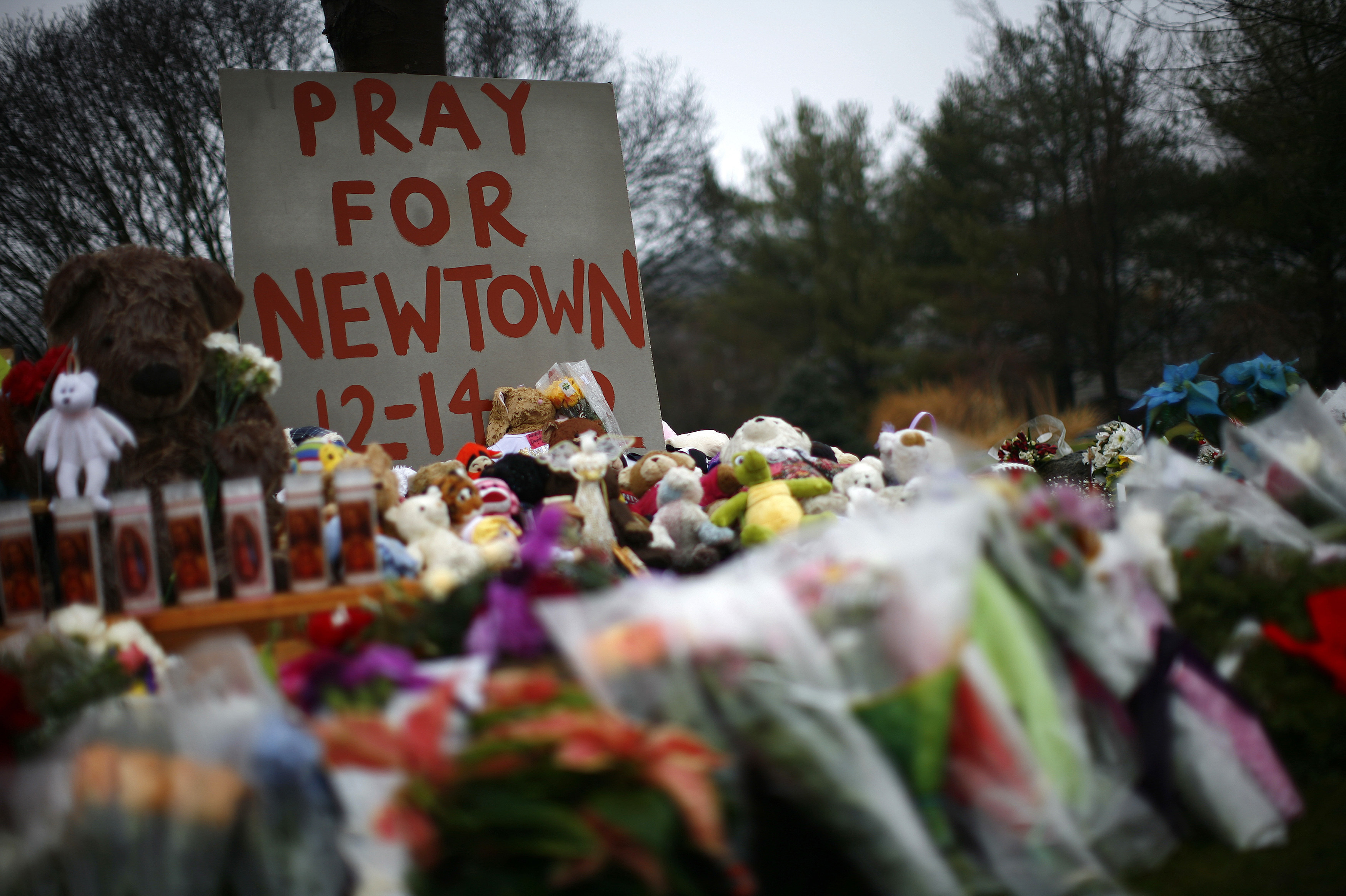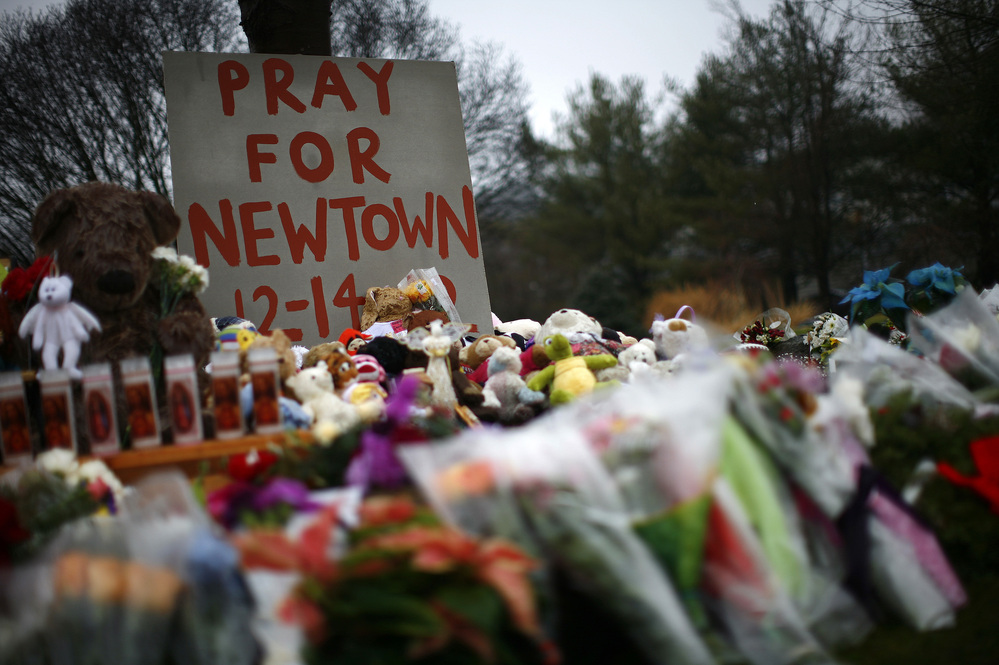Flowers, candles and stuffed animals make up a makeshift memorial in Newtown, Conn., on Monday. Much of the initial news coverage of Friday's events was later found to be inaccurate.
Flowers, candles and stuffed animals make up a makeshift memorial in Newtown, Conn., on Monday. Much of the initial news coverage of Friday's events was later found to be inaccurate.
Eric Thayer/Reuters/LandovNearly everyone reported so many things wrong in the first 24 hours after the Sandy Hook shootings that it's hard to single out any one news organization or reporter for criticism.
Among the news outlets that wrongly reported major parts of the journalistic building blocks of "who, what, where, when, why and how," were CBS, the Associated Press, The New York Times and NPR â€" a veritable honor roll of the mainstream media. Many of the reports relied on unnamed law enforcement officials, typically federal, or even the vaguer "the authorities," in at least one instance.
“ [In any major story] there's going to be a massive, fast conversation on social media, and on Twitter in particular, trying to figure out everything they can about anyone whose name has appeared. And the idea the professionals have nothing to do with that conversation strikes me as a bad idea.
The citation of federal sources typically indicated the nature of the Washington and New York-based reporters doing the reporting, rather than the originating sources of information itself.
A Series Of Mistakes
Just before 3 p.m. on Friday, for example, Fox News told viewers that "cops" had identified the shooter as a 24-year-old man named Ryan Lanza. Not on the record, they hadn't, and it wasn't Ryan Lanza. CNN went a step further, quoting a federal law enforcement official who told the network's John King that Ryan Lanza was "not a stranger to the school."
There is currently no known evidence linking the actual shooter â€"- Ryan's younger brother Adam -â€" to the school. On MSNBC, reporters told viewers that the shooter's apartment in Hoboken, N.J., was being searched by police (again wrong â€" it was Ryan's apartment) and that he walked into his mother's kindergarten class and fatally shot her there before murdering her students.
In fact, local police soon enough announced, on the record, that Lanza's mother, Nancy, was killed at her home; school officials said she did not teach kindergarten, nor any grade or course at the school; that she did not work there nor did they have record that she was a volunteer. As a result, the principal did not admit the shooter inside the campus because he was known to her, as was wrongly reported by various outlets. Police later said he had physically forced his way inside.
Another report that Adam Lanza had confronted teachers the day before the shooting proved equally mistaken.
It was journalistic bedlam.
Some news outlets signaled their mistakes and that stories were shifting; others glossed over them with updated information, as though they had held the facts all along. But it led to a dizzying sense of impermanence to any description of what had actually transpired.
"A guy was misidentified as a mass murderer," said Ben Smith, editor-in-chief of BuzzFeed, which straddles the worlds of traditional news outlets and social media platform. "That's horrendous."
BuzzFeed relied on reporting from CNN and other outlets identifying the wrong brother, Ryan, as the killer and then took the additional step only now possible: its staffers chased down his picture and postings on his Facebook page and to slap his own image and words on the site â€" it was not alone in doing so.
The New York Times' public editor, Margaret Sullivan, argues in a blog post containing a staggering rundown of the paper's errors that its journalistic missteps were driven by the push to meet the speed of expected social media platforms.
A Change In Consumption, Not Coverage
For many journalists, the misguided stories fall under the rubric of the "fog of war" -â€" the truism that first reports amid chaos are likely to be the least accurate. It's true, and yet cloaks many a journalistic sin over the years. But even in the pre-Internet age, journalists have also been badly mistaken.
In just one of many examples, all three broadcast television networks reported that then White House Press Secretary James Brady had been killed in the assassination attempt on President Reagan. He survived and became one of the nation's leading gun control advocates.
In this case, the stories were off the mark, but reporters didn't make them up. By all indications, law enforcement officials offer mistaken leads in many cases to reporters they knew for years, yet news organizations chose not to wait until such factual material was confirmed on the record.
Buzzfeed's Ben Smith has worked in the past for more conventional outlets such as the Indianapolis Star, the New York Daily News and Politico. He said coverage of such crises has not changed, but the way in which reporters construct it and readers and viewers consume it has. Now, he said, the assemblage of the news is playing out in full view and in real time.
"[In any major story] there's going to be a massive, fast conversation on social media, and on Twitter in particular, trying to figure out everything they can about anyone whose name has appeared," Smith said. "And the idea the professionals have nothing to do with that conversation strikes me as a bad idea."
And yet, as a result, millions of people will remember the face of the wrong guy as a killer of children by millions of people, until the media darts en masse in an entirely different direction like a vast school of small fish.
It took writer Dave Cullen a decade to report and write an authoritative account of the 1999 shootings at Columbine High School in Colorado. He said the media had established to its own satisfaction exactly why the teens turned into killers within just a few days.
Thanks to the media, Cullen said, "We knew unequivocally that they were kind of loner outcasts â€" goths from the trench coat mafia, who had done this as a revenge slaying, primarily against jocks to pay them back for the relentless bullying they had undergone."
One problem, Cullen found that none of that was true. He argued it is unfair to expect precision from the press immediately after a crisis starts, but that journalists must move with lightening speed to correct themselves. Yet such errant reporting in Connecticut created an opportunity for real harm.
"In the meantime, all sorts of people jump to all sorts of conclusions about what that means and why he did it, and I thought that was irresponsible," Cullen said.
Amid catastrophe and crisis, the press is writing in pencil, erasing it and trying again. So in stories like these, the first draft of history isn't even a draft. It's just raw notes, waiting for rewrite.




